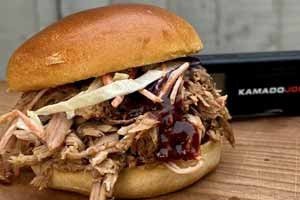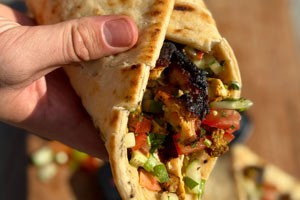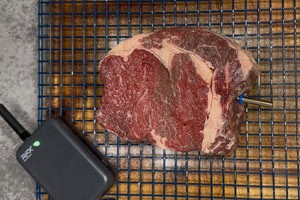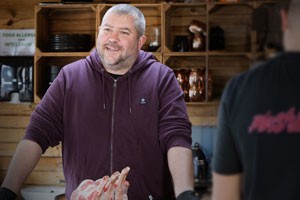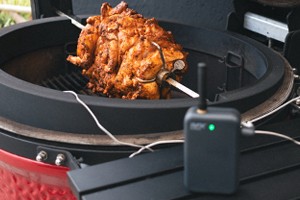Easy, tender BBQ pulled pork, loaded into buns with coleslaw and BBQ sauce.
30 Chefs' Cooking Tips Everyone Should Know
This year we are celebrating 30 years of Thermapen. Our 30 years of helping professional chefs and home cooks to produce safe and succulent food have seen us collaborate with many talented foodies. So to commemorate this big birthday, we have gathered 30 of the best cooking tips and tricks that have been shared with us over the years.
We've included simple cooking tips, fun cooking tips and cooking tips for beginners. And of course, we've thrown some temperature tips in there as well.
Tip 1. Don’t cook meat straight from the fridge.
“Bring meats up to room temperature for 30-40 minutes before putting them on the BBQ. The high heat will penetrate the meat easier, cooking it faster and keeping it tender.”
— Richard Holden, Top 10 BBQ Tips
Tip 2. Never change the quantities in a baking recipe.
“One of the worst things you can do in any baking recipe is alter the quantities. You’re gambling with the recipe and praying that it turns out ok. And I’ve generally already done the hard work there for you!”
Tip 3. Pair the right flavours with your fish.
“Let the ingredients speak for themselves, especially if you have really fresh fish. If you’re more experimental, choose the right fish. Monkfish or salmon takes on flavour really well as it can stand up to the seasoning.”
Tip 4. If you’re looking, it’s not cooking.
“You’ll be tempted to peek or spritz. Do not! All this will achieve is disrupting your pit temperature. We don’t even spritz on low and slow cooks since we find it interrupts the bark development but doesn't affect the moisture of the meat.”
— Bonaparte Barbecue’s Brisket, Pork Ribs & Hot Links
Tip 5. Barbecue to temperature, not time.
“In barbecue it’s important to cook to temperature not time. Forget precise timings and learn to adopt a ‘it’s done when it’s done’ attitude to cooking. Every fire you light will be slightly different to the one before – wind, air temperature, humidity all play a role – and so you need to roll a little with the variations.
— Genevieve Taylor, 8 Tips for the Best National BBQ Week
Tip 6. Rest your meat for the right amount of time.
“The best rule to follow is to rest the meat at least as long as you cook it.”
— Kenny Tutt, Côte De Boeuf, Tomahawk & Chateaubriand Recipe
Tip 7. Avoid bones when taking temperatures.
“Be careful not to hit any bones when taking the temperature as this will give a false reading. Insert the probe into the thickest part of the meat for the best indication.”
— Jim Moore, Cooking to Temperature Over Time
Tip 8. Don’t bake a cake in naked tins.
“Always grease and line your baking tins, even if they are non-stick. Your cakes will be so much easier to remove if you do.”
— Little Sugar Snaps, Chocolate Cherry Cake Recipe
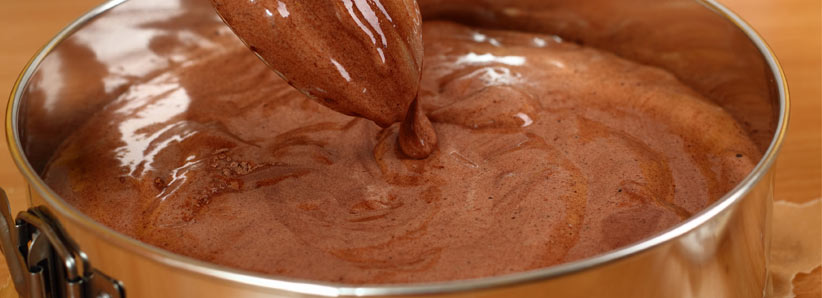
Tip 9. Food thermometers aren’t just for meat.
“Food thermometers are perhaps thought of as mainly useful for meat, but as a vegetarian, I still use it all the time. It's particularly useful for bread as well as plenty of sweet treats.”
— Veggie Desserts, Mini Chocolate Tarts with Caramel Sauce Recipe
Tip 10. Use smoking woods when cooking BBQ food.
“Adding some wood to the charcoal mix changes the flavour profile entirely, imparting even deeper smoky notes into the food. This is where cooking becomes really fun, allowing you to play around with smoky flavours. Think of smoke like a seasoning, like salt and pepper.”
— Ben Forte, An Introduction to Ceramic Grills with Kamado Joe
Tip 11. Vacuum seal meat before freezing.
“Vacuum sealing is the most effective way to protect foods such as meat against freezer burn. By removing the air from the package, the ice crystals have nowhere to migrate, locking the moisture into your food.”
— The Full Freezer, How to Perfectly Preserve Meat Using Your Freezer
Tip 12. Set your jam to the right temperature.
“While it’s a rule of thumb to cook jams to a setting point of 105 °C, if cooking a recipe where there is less sugar, the jam will set at around 103-104 °C. But if you want to be sure of a firmer set, take your jam to 105 °C.”
— Perfectly Preserved, Mixed Berry Lamb with Juniper & Lime Recipe
Tip 13. Use carefully sourced mince for rarer burgers.
“Make sure you know where your beef mince comes from if you want to have it pink in the middle. I would always cook supermarket meat to medium well to well done. I trust my local butcher’s beef mince and will cook the occasional burger medium rare to medium when using carefully sourced beef mince.”
— DJ BBQ, Top Tips for Cooking the Perfect Burger
Tip 14. Make taking food temperatures fun.
“My kids love watching the temperature climb, so make a game of it. Try getting them to guess the temperature, or the first one to shout when we reach the target temperature wins.”
— At Dad’s Table, Family-Friendly BBQ Chicken Drumsticks Recipe
Tip 15. Use the window pane test on bread dough.
“To check if your dough has been kneaded enough, you can use the window pane test. Tear off a small ball of dough and stretch it between your fingers into a thin, translucent window. If the dough stretches without breaking it’s ready to prove.”
— Colm Tohill, Rustic Sourdough Bread Recipe
Tip 16. Dry brine your Christmas turkey for crispy skin.
“I like to dry brine the turkey. The salt will initially draw the moisture out of the turkey but then through the magic of osmosis, the salt and the moisture will be drawn back into the turkey, locking in flavour and ensuring you’ll get nice crispy skin.”
— The Smokin’ Elk, Guide to Barbecuing Your Chrismas Turkey
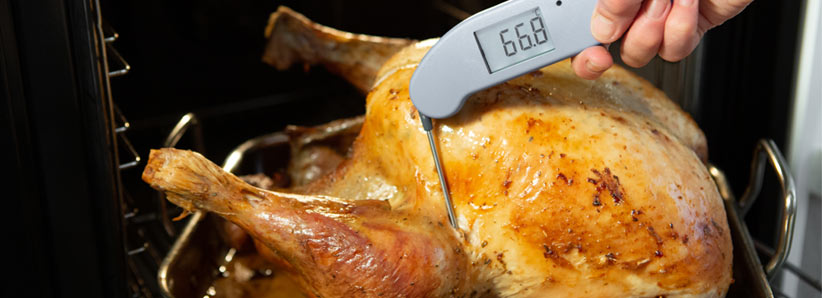
Tip 17. Don’t take the temperatures of thin meats in the pan.
“If you’re cooking a thin cut of meat like a pork chop, use kitchen tongs to lift it up then insert the probe sideways to reach the centre.”
— Little Sunny Kitchen, How to Use a Kitchen Thermometer
Tip 18. Rub oil into steaks before pan-frying.
“Rub olive oil into the steaks. This makes sure that you have oil under the whole steak to form even contact with the pan rather than just adding oil to the pan, where you may have some spots where the oil pools and somewhere you don’t get any oil at all.”
— Salted Mint, Pan Seared Steak & Mushrooms
Tip 19. Use the right bowl for chocolate tempering.
“Avoid melting your chocolate in glass or metal bowls. Glass retains the heat, and cooling is a crucial step in tempering chocolate.”
— SoSaSe, The Ultimate Guide to Tempering Chocolate
Tip 20. Take your Thermapen travelling.
“My Thermapen is an essential bit of kit that I couldn’t cook without at home or overseas. I love putting it in my pocket and taking it to beach barbecues with the family.”
— The Moody BBQ, Ultimate Thai Fakeaway Recipe
Tip 21. Form burger patties by hand.
“I like to weigh out each patty and then form them by hand. They may not be perfectly circular but by using my hands, I can ensure they are handled with care and the texture inside the burger is loose and airy – which will give the rendering fats room to move throughout the burger.”
— Barbechoo, 3 Favourite Burger Recipes
Tip 22. Serve baby food at a safe temperature.
“Mashed foods should be served between 21-37.5° C. This ensures the food is properly warmed through but will not burn your child’s mouth.”
— Charlotte Stirling-Reed, Top Tips for Weaning
Tip 23. Sear meat to build flavour and texture.
“When cooking a joint of beef like beef rib, searing is important as it builds flavour and texture. This locks in the flavour ready to cook in the oven.”
— Simon May, Buying Beef From Your Local Butcher
Tip 24. Don’t be scared of pork pie jelly.
“I know a lot of people freak out about the jelly in a pork pie. But if it is well seasoned, it is delicious. And it’s really good for you too. It contains collagen, amino acids, protein, glucosamine and minerals among other things.”
— The Hedgecombers, British Pork Pie Recipe
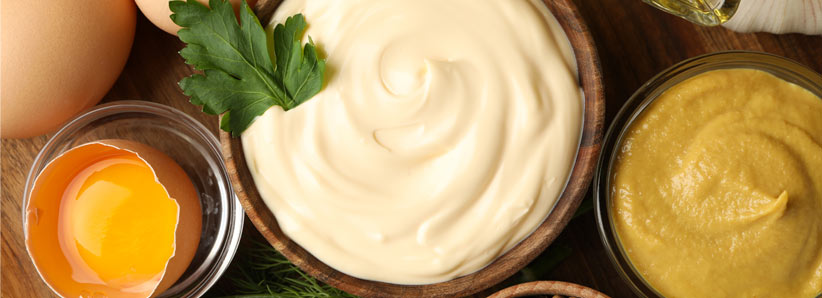
Tip 25. Pasteurize your eggs.
“Many people don’t pasteurize their eggs when making things like mayonnaise or a dessert mousse. However, this can carry a risk of foodborne illnesses, especially to more vulnerable people. Pasteurizing your eggs will remove this risk, making the eggs safe for everyone to enjoy.”
— Movers & Bakers, Chocolate Brownie Mousse Cake Recipe
Tip 26. Prepare lobster safely.
“Make sure you keep your lobsters alive right up until you want to cook them. Dispatching the lobsters in advance will lead to a mushy texture, the moment the lobster dies enzymes start to de-nature the proteins.”
— Humble Plates, Grilled Lobster with Garlic Butter & French Fries Recipe
Tip 27. Know what makes a good jerk chicken.
“The jerk chicken I love has got to be hot, but not too hot. You can always drizzle hot sauce over it, but you can't take the heat out. It needs to be moist so you mustn't overcook it and dry it out. It has also got to be full of the taste of BBQ smoke.”
— The Smoking Gunn, BBQ Jerk Chicken
Tip 28. Use lemons to secure multiple skewers together.
“You can use a double-pronged skewer or two single skewers and secure the ends with half a lemon to keep them parallel.”
— Jon Bradburn, Korean-Style Chicken Shawarma
Tip 29. Blackberry jam sets differently depending on where your berries are from.
“Shop-bought blackberries are larger and sweeter than the foraged ones. They are also lower in pectin so you will need to add some lemon juice to aid the setting.”
— Supergolden Bakes, Easy Homemade Blackberry Jam Recipe
Tip 30. Get ready before you start cooking.
“Be prepared. Have all your ingredients to hand either cut or weighed so you can enjoy the cooking process, and not get stressed if there’s an ingredient missing. Also, use your appliances and equipment. They are there for a reason, don’t let them gather dust!”
— Laura Tulloch, Thermapen Chef





